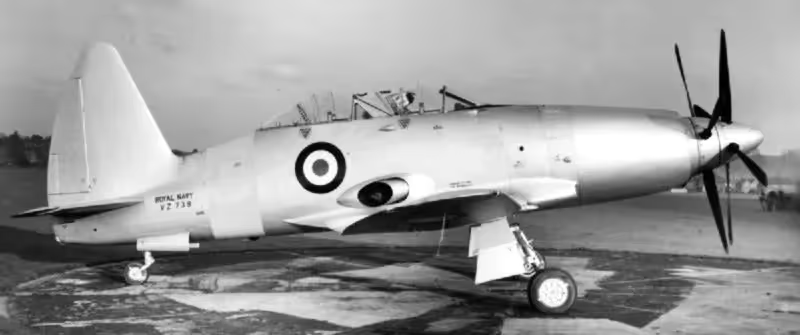Warplanes of the UK: Westland Wyvern
Westland Wyvern

(RN Photo)
The Westland Wyvern is a British single-seat carrier-based multi-role strike aircraft built by Westland Aircraft that served in the 1950s, seeing service in the 1956 Suez Crisis. Production Wyverns were powered by a turboprop engine driving large and distinctive contra-rotating propellers, and could carry aerial torpedoes.

(RN Photo)
Westland Wyvern S Mk. 4.
The first carrier trials were carried out by the first pre-production Wyvern TF.2 aboard HMS Illustrious on 21 June 1950.[5] Despite this, when the Wyvern S.4 entered service with 813 Naval Air Squadron in May 1953, it had not obtained clearance for carrier operations, this being obtained only in April 1954.[6] The Wyvern was in service with the Fleet Air Arm from 1954 to 1958. Wyverns equipped 813 Squadron, 827 Squadron, 830 Squadron and 831 Squadron of the Fleet Air Arm.In September 1954, 813 embarked with their Wyverns on HMS Albion for carrier-based service in the Mediterranean. The Wyvern soon showed a worrying habit for flameout on catapult launch: the high G forces involved caused fuel starvation. A number of aircraft were lost off Albion's bow and Lt. B. D. Macfarlane made history on 13 October 1954[7] when he successfully ejected under water using his Martin-Baker Mk.1 ejection seat after his aircraft had ditched on launch and been cut in two by the carrier. 813 did not return to Albion until March 1955 when the problems had been resolved.
No. 830 Sqn. took the Wyvern into combat from HMS Eagle, flying 79 sorties[8] during Operation Musketeer, the armed response to the Suez Crisis. Two Wyverns were lost to damage from Egyptian light anti-aircraft fire; the pilots of both aircraft successfully ejected over the sea and were picked up by Eagle's search and rescue helicopter. The squadron returned to the UK on Eagle after this conflict and disbanded in January 1957. Consequently, 813 was the last Wyvern squadron, disbanding on 22 April 1958.[1]All Wyverns were withdrawn from service by 1958: while in service and testing there were 68 accidents, 39 were lost and there were 13 fatalities, including two RAF pilots and one United States Navy pilot. (Wikipedia)
.avif)
(SDASM Photo)
Westland Wyvern T.F. Mk. 2, Nov 1948.

(B.J. Lowe Photo)
Wyvern S.4 WP338 J 377, 830 Sqn, flown by Lt. Dennis McCarthy sits perilously close to the edge of HMS Eagle.

(JDR Rawlings Photo)
Westland Wyvern S.4 (Serial No. VZ753), coded ‘183’ was delivered to the first front line squadron, No. 813 Sqn at Ford on 6 June 1953.

(RN Photo)
Westland Wyvern on a RN Aircraft Carrier, c1956.

(RN Photo)
Westland Wyvern on a RN Aircraft Carrier, c1956.
Variants:
- W.34 Wyvern
Six prototypes ordered in August 1944, with the first aircraft flown 12 December 1946. Powered by the Rolls-Royce Eagle Mk 22 H-block, piston engine.
- W.34 Wyvern TF.1
Pre-production aircraft ordered in June 1946, with only seven built of 20 contracted due to the cancellation of the Eagle powerplant.
- W.35 Wyvern TF.2
The original production version, powered by the Armstrong Siddeley Python turboprop in replacement of the discontinued Eagle piston powerplant seen on the W.34 prototypes. Three prototypes were ordered in February 1946 with a production contract for 20 aircraft issued in September 1947. Only nine production aircraft were built, and the remaining eleven were completed as S.4s.
- W.38 Wyvern T.3
Two-seat conversion trainer. One prototype serialed VZ739 was ordered in September 1948 and first flown in February 1950.
- W.35 Wyvern TF.4
The definitive version. 50 were ordered in October 1948, 13 in December 1950, 13 in January 1951 and a final 11 in February 1951. A total of 98 built (including 11 that had started as TF.2s). The model was later redesignated as the S.4.

(IWM Photo, ATP 18771C)
The only Westland Wyvern T.3 trainer aircraft built (serial VZ739). This aircraft was converted in 1950 and scrapped in 1953.

(RuthAS Photo)
Westland Wyvern TF.1 (Serial No. VR137) on external display at the FAAM Yeovilton in 1971.


(Mike Freer - Touchdown-aviation Photos)
An unflown pre-production aircraft, the last to be fitted with the original Eagle piston engine, (Serial No. VR137) is on display at the Fleet Air Arm Museum in Yeovilton, England.





